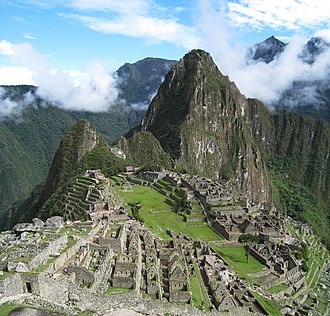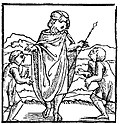Inca Empire
The Inca were a pre-Columbian country and empire in the Andes of South America. The word 'Inca' can also mean the emperor or king of the Inca people. The Inca Empire was called Tawantinsuyo in Quechua, which means "four regions".
Inca Empire Tawantinsuyu (Quechua) | |
|---|---|
| 1438–1533/1572 | |
 The Inca Empire at its largest size c. 1525 | |
| Capital | Cusco |
| Official languages | Quechua |
| Religion | Inca religion |
| Government | Divine, absolute monarchy semi-diarchy |
| Historical era | Pre-Columbian era |
• | 1438 |
| 1529–1532 | |
• | 1533/1572 |
• End of the last Inca resistance | 1572 |
| Area | |
| 1527 | 2,000,000[1][2] km2 (770,000 sq mi) |
It was the largest empire in the Americas, and was large even by world standards. It existed shortly before Christopher Columbus arrived in the Americas. It lasted for 100 years, until it was conquered by Spanish soldiers in 1532 AD.
Overview
The Inca were ruled by an Emperor known as the Sapa Inca. Their main language was Quechua, but since there were many different groups in the Empire, there were probably many different languages as well.
The Empire was supported by an economy based on the collective ownership of the land.
Location
The Inca ruled along the western coast of South America for a little over 100 years, until the Spanish invasion in the 16th century.
The empire was centered around the city of Cuzco, or Qosqo, in what is now southern Peru. This was the administrative, political and military center of the empire. In later years, it became centered around Quito.
History
Growth
The Inca Empire began around Lake Titicaca in about 1197. From 1438 to 1533, the Incas used conquest and non-violent assimilation to gain a large portion of western South America. Their empire centered on the Andean mountain ranges. It included large parts of what is now Ecuador, Peru, Bolivia, Argentina and Chile.
Road network
Throughout their empire, they built a network of roads and rope bridges to make travel between their communities easy.
Beginning of Spanish rule
In 1533, Atahualpa, the last sovereign emperor, was executed by the conquistador Francisco Pizarro. That marked the beginning of Spanish rule in South America.
Also see
Inca Empire Media
Manco Capac, First Inca, 1 of 14 Portraits of Inca Kings, Probably mid-18th century. Oil on canvas. Brooklyn Museum
Manco Cápac and Mama Ocllo, children of the Inti, Felipe Guaman Poma de Ayala, El primer nueva corónica y buen gobierno, circa 1615
The Inca Empire's expansion according to John Howland Rowe in his "absolute chronology", developed in 1944–1945.
The first image of the Inca in Europe, Pedro Cieza de León, Crónica del Perú, 1553
Capaccona or Qhapaqkuna "the kings", a 17th-century Cusco painting with the Inca lineages mentioned by colonial chronicles and their relationship with the royal queens of Cuzco, which hide behind a complex representation of the Inca social organization.
Atahualpa, the last Sapa Inca of the empire, was executed by the Spanish on 29 August 1533. Painting by Luis Montero.
Facade of the Church and Convent of Santo Domingo in Cusco, built on the base of the Coricancha
The Inka and his wife, the Quya, traveling the Qhapaq Ñan.
References
- ↑ Turchin, Peter; Adams, Jonathan M.; Hall, Thomas D (December 2006). "East-West Orientation of Historical Empires". Journal of World-Systems Research. 12 (2): 222. ISSN 1076-156X. Retrieved 16 September 2016.
- ↑ Rein Taagepera (September 1997). "Expansion and Contraction Patterns of Large Polities: Context for Russia". International Studies Quarterly. 41 (3): 497. doi:10.1111/0020-8833.00053. ISSN 0020-8833. JSTOR 2600793. Retrieved 7 September 2018.
Bibliography
- Popenoe, Hugh et al 1989. Lost crops of the Incas. Washington DC: National Academy Press.
- De la Vega, Garcilaso 1961. The Incas: the royal commentaries of the Inca. New York: The Orion Press.
- McNeill, William H. 2006. How the potato changed the world's history. Social Research 66 1.
Other websites
- Conquest of Peru, Prescott, 1847 Archived 2006-07-08 at the Wayback Machine Full text, free to read and search, a definitive history of the Incas. One of the most readable and engaging history books of all time. Humankind lost a civilization of impressive societal value.
- Inca Land by Hiram Bingham (published 1912–1922)
- Inca Artifacts, Peru, and Machu Picchu Archived 2007-01-29 at the Wayback Machine 360 degree movies of inca artifacts and Peruvian landscapes.
- Inca civilization and other ancient civilizations by Genry Joil.
- Inca stone cutting techniques: theory on how the Inca walls fit so perfectly.
- Ancient Civilizations - Inca Archived 2007-02-04 at the Wayback Machine Great research site for kids.
- Incan Ice Mummies NOVA site based on their series about the 1996 expedition that discovered Incan ice mummies.
- Incan Religion Archived 2007-03-05 at the Wayback Machine











